
Science with Passion
Application No.: VBS0086
Version 1 05/2025
Fast protein analysis of mucins using an AZURA® SEC System
J. Wesolowski1, J.L. Dauwe2, C. Dauwe2, J. Kramer1, K. Folmert1, G. Greco1;
wesolowski@knauer.net
1 KNAUER Wissenschaftliche Geräte GmbH, Hegauer Weg 38, 14163 Berlin

2 AppliChrom GmbH®, Germendorfer Allee 20, 16515 Oranienburg bei Berlin,
https://www.applichrom.de
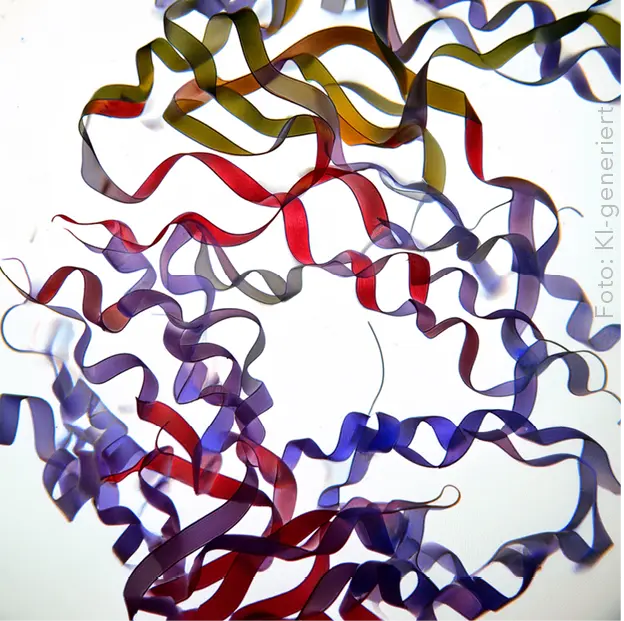
Summary
The KNAUER AZURA® SEC System is known as a robust Gel Permeation Chromatography (GPC) or Size Exclusion Chromatography (SEC) system for advanced applications as well as high-throughput analysis. In combination with an AppliChrom® VivoSep column we demonstrate the performance of the KNAUER AZURA® SEC System for the analysis of commercially available bovine submaxillary mucin and porcine gastric mucin. The VivoSep SEC column material uses a multi-stage, hydrophilic modified polymer-based design that enables high-resolution analyses of proteins over a wide molecular weight range.
Introduction
Mucins are glycoproteins, which are characterised by a combination of proteins and carbohydrates [1].
They play an important role in biological processes, particularly in the protection of mucous membranes against mechanical, chemical and biological influences [2]. Due to their high content of sugar molecules, mucins have a strong hydrophilic tendency, which helps them to bind water and form a gel-like consistency [3 ,4 ,5]. They are part of a mixture of water, salts, lipids, cell material and other proteins that form the mucus that covers the surfaces of the mucous membranes of organisms such as the mouth and nose [1, 2]. Thereby, the mucins are crucial for the physical properties of the mucus, especially its viscosity [1].
An important analytical tool for the characterisation of mucins is SEC1. This method allows the determination of the molecular weight and molecular weight distribution of mucins, contributing to a better understanding of their biological functions [1]. In addition, SEC allows efficient isolation of mucins from biofluids, resulting in purified mucin fractions that can be used for further analysis or medical applications, such as biomarkers in cancer diagnosis and prognosis [6, 7]. Overall, SEC is a gentle chromatographic technique performed under mild conditions such as room temperature and neutral pH [8]. This ensures that the native conformation and function of the mucins are maintained throughout the separation process, which is crucial for preserving their biological activity and interactions [8].
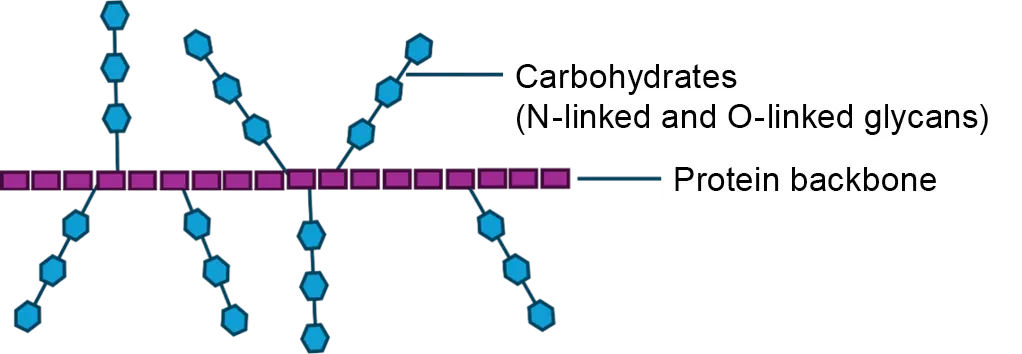
Fig. 1 Model of the glycoprotein structure of mucins.
Sample Preparation
Commercially available bovine submaxillary mucin and porcine gastric mucin samples were used for the analysis.
Results
The most commonly used materials in SEC include cross-linked dextran or agarose (Sephadex/Sepharose), polyacrylamide beads (Bio-Gel), and dextran derivatives (Sephacryl) [9]. AppliChrom® has developed the VivoSep SEC series which enables high resolution separations of proteins. This special multistage hydrophilic modified polymer-based SEC column offers significantly expanded capabilities for analysing larger proteins by covering a molecular weight range from 100 Da to 5 000 000 Da. Here, we demonstrate that this column material, in conjunction with the KNAUER AZURA® SEC System, is suited for straightforward measurements of and porcine gastric mucin (Fig. 2) and bovine submaxillary mucin (Fig. 3). The shown data for this application note were provided by AppliChrom®.
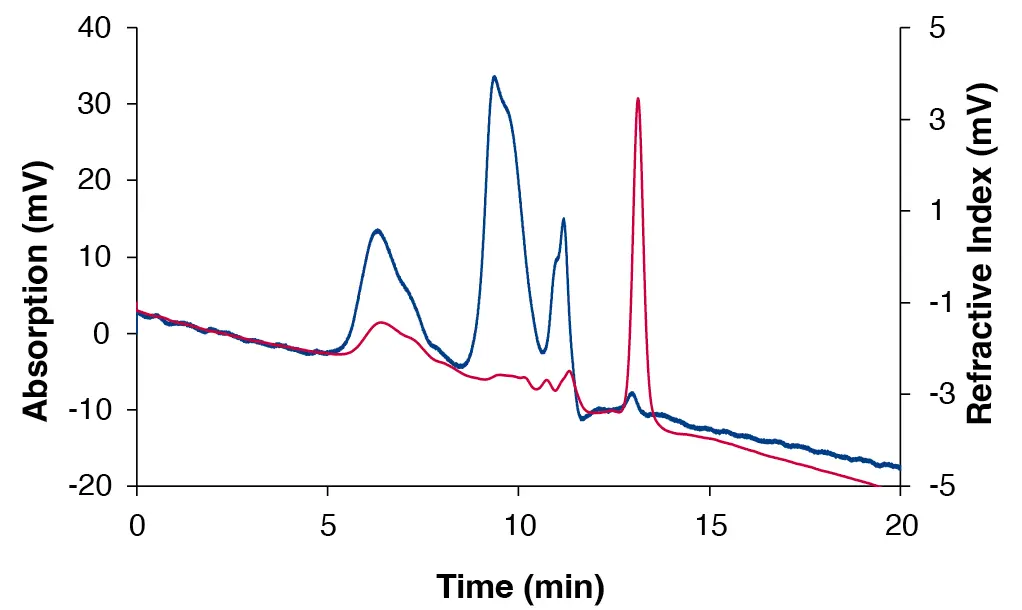
Fig. 2 Chromatogram of the porcine gastric mucin measured with the VivoSep SEC 350 (separation range 2 500 - 1 000 000 Da), DAD at 220 nm (blue) and RID (red).
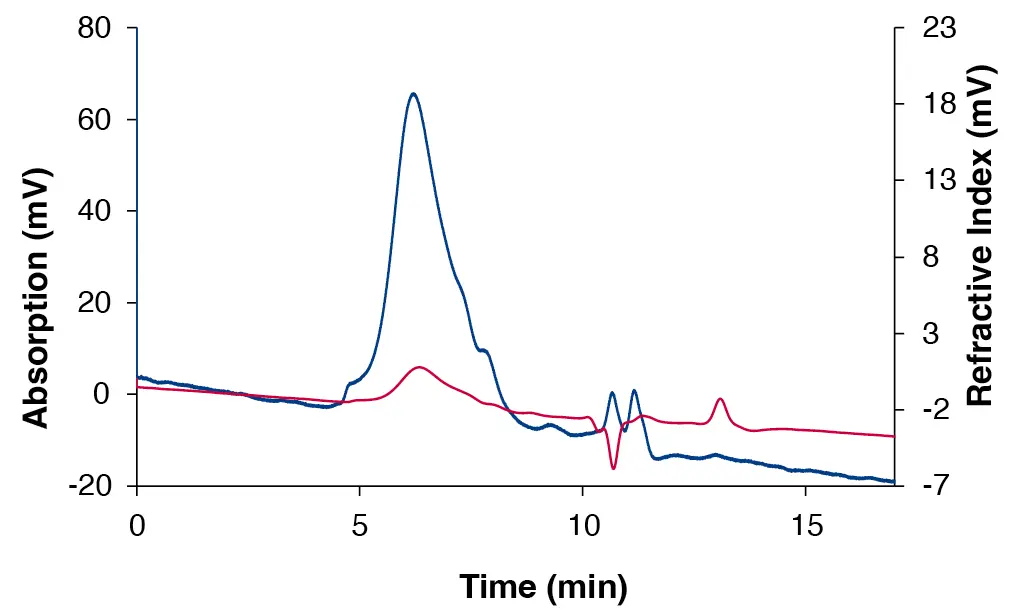
Fig. 3 Chromatogram of the bovine submaxillary mucin measured with the VivoSep SEC 350 (separation range 2 500 - 1 000 000 Da), DAD at 220 nm (blue) and RID (red).
It has been shown that mucins can be analysed in 15 minutes (Fig. 2 and Fig. 3). In contrast, analysis using common columns with cross-linked dextran or agarose based resins require up to 300 minutes10. In addition, AppliChrom® VivoSep SEC columns have an excellent pressure stability of 50 to 200 bar, depending on the pore size. In comparison, cross-linked dextran SEC columns are only stable at pressures of 5 bar or less. This high pressure stability also allows the use of smaller particles (7 - 10 µm), which results in enhanced separation performance.
Conclusion
The KNAUER AZURA® SEC System in combination with the AppliChrom® VivoSep SEC column offers significant time savings for the analysis of mucins. This solution provides good separation performance and is an innovative addition to the field of protein size exclusion chromatography.
Material and Methods
Tab. 1 Method parameter.
Parameter | Value |
Flow rate | 1 ml/min |
Isocratic | H2O / PBS-Buffer |
Column temperature | 25 °C |
Injection volume | 8 µl |
Injection mode | Partial loop |
Detection 1 | DAD 220 nm |
Detection 2 | RID |
Data rate | 10 Hz |
Time constant | 0.1 s |
Time | 20 min |
Tab. 2 System configuration.
Instrument | Description | Article No. |
Pump | AZURA® P 6.1L LPG Pump with 10 ml pump head, stainless steel | |
Autosampler | AZURA® AS 6.1L, analytical HPLC autosampler, 862 bar | |
Detector 1 | AZURA® DAD 2.1L, 190 - 700 nm | |
Detector 2 | AZURA® RID 2.1L, analytical refractive index detector | |
Thermostat | AZURA® CT 2.1 | |
Eluent tray | AZURA® E 2.1L | |
Column | AppliChrom® VivoSep SEC 350, 10 µm, | |
Capillaries | Start-Up Kit with flexible, precut capillaries for analytical HPLC systems with 1/16" connections | |
Software | ClarityChrom® 9.1.0 - Workstation, autosampler control included | |
Software | ClarityChrom® 9.1.0 - SEC/GPC extension |
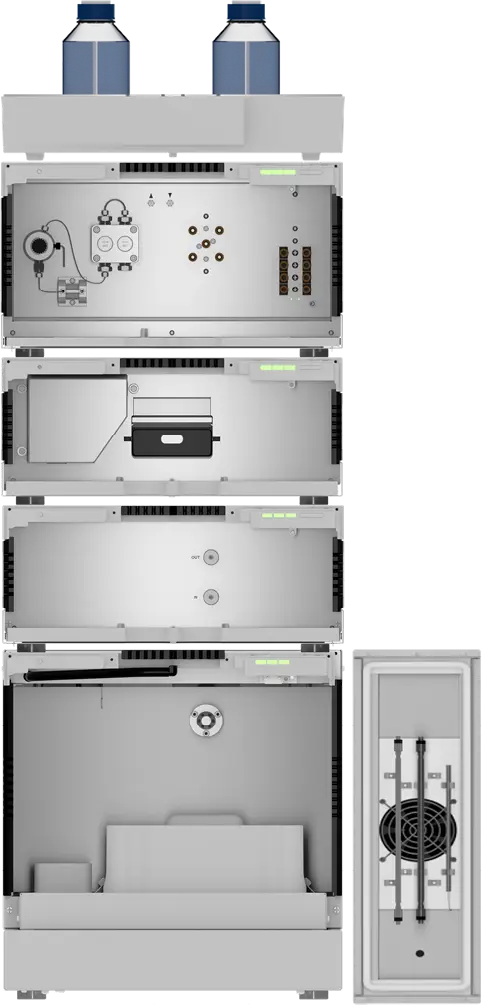
Fig. 4 SEC system setup.
References
[1] Jumel, K., Fiebrig, I. & Harding, S. E. (1996). Rapid size distribution and purity analysis of gastric mucus glycoproteins by size exclusion chromatography/multi angle laser light scattering. International Journal Of Biological Macromolecules, 18 (1-2), 133-139.
[2] Schoemig, V., Isik, E., Martin, L. & Berensmeier, S. (2017). Solid liquid liquid extraction of porcine gastric mucins from homogenized animal material. RSC Advances, 7 (63), 39708-39717.
[3] Johansson, M. E. V., Larsson, J. M. H. & Hansson, G. C. (2010). The two mucus layers of colon are organized by the MUC2 mucin, whereas the outer layer is a legislator of host–microbial interactions. Proceedings Of The National Academy Of Sciences, 108 (supplement_1), 4659-4665.
[4] Crouzier, T., Boettcher, K., Geonnotti, A. R., Kavanaugh, N. L., Hirsch, J. B., Ribbeck, K. & Lieleg, O. (2015). Modulating Mucin Hydration and Lubrication by Deglycosylation and Polyethylene Glycol Binding. Advanced Materials Interfaces, 2 (18).
[5] Schömig, V. J., Käsdorf, B. T., Scholz, C., Bidmon, K., Lieleg, O. & Berensmeier, S. (2016). An optimized purification process for porcine gastric mucin with preservation of its native functional properties. RSC Advances, 6 (50), 44932-44943.
[6] Schuster-Little, N., Sokolovsky, A. D., Gentry, A., Saraf, A., Etzel, M. R., Patankar, M. S. & Whelan, R. J. (2024). Immunoaffinity-free chromatographic purification of ovarian cancer biomarker CA125 (MUC16) from blood serum enables mass spectrometry characterization. Analytical Methods, 16 (37), 6337-6348.
[7] Felder, M., Kapur, A., Gonzalez-Bosquet, J., Horibata, S., Heintz, J., Albrecht, R., Fass, L., Kaur, J., Hu, K., Shojaei, H., Whelan, R. J. & Patankar, M. S. (2014). MUC16 (CA125): tumor biomarker to cancer therapy, a work in progress. Molecular Cancer, 13 (1).
[8] Hall, M. (2018). Size Exclusion Chromatography (SEC). Biopharmaceutical Processing, 421-432.
[9] Hostettmann, K., Marston, A. & Hostettmann, M. (1998). Separation of Macromolecules. Preparative Chromatography Techniques (202-216).
[10] Sandberg, T., Blom, H. & Caldwell, K. D. (2008). Potential use of mucins as biomaterial coatings. I. Fractionation, characterization, and model adsorption of bovine, porcine, and human mucins. Journal Of Biomedical Materials Research Part A, 91A (3), 762-772.
Application details
|
Method |
GPC/SEC |
|
Mode |
GPC/SEC |
|
Substances |
Bovine submaxillary mucin, porcine gastric mucin |
|
CAS number |
84082-64-4, 84195-52-8 |
|
Version |
Application No.: VBS0086 | Version 1 5/2025 | ©KNAUER Wissenschaftliche Geräte GmbH |


